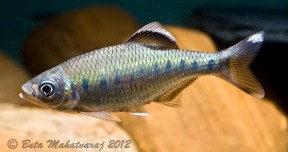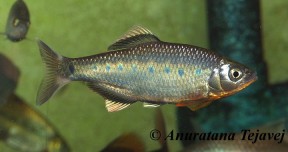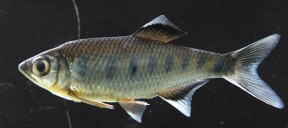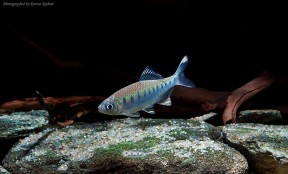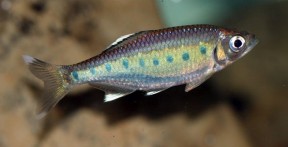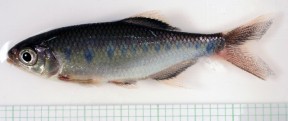Barilius bakeri
Etymology
Barilius: from barila, a vernacular Bengali name for the species B. barila, the type species.
bakeri: named for Rev. H. Baker, who collected specimens of this species from Mundikyum (see ‘Distribution’).
Classification
Order: Cypriniformes Family: Cyprinidae
Distribution
Endemic to the Western Ghats mountains, southwestern India.
In Kerala state records exist from the Periyar, Kabini, Chalakudy, Valapatanam, Chaliyar, Neyyar, Pampa, Vamanapuram, Kallada, Ithikkara, Karamana, Bharatapuzha, Muvattupuzha, Meenachil, Manimala, Achankovil, Pambar, Chandragiri, Karyangode, Kuppam, and Bahavani river systems. In Karnataka it is known from the Indira Gandhi Wildlife Sanctuary, and in Tamil Nadu the Chittar, Periyar, and Pampa river basins.
Type locality is given as ‘the hills at Mundikyum, Cochin, India’ which appears to correspond to the small town now known as Mundakayam, in Kottayam District of Kerala state. The Manimala river flows through the town and eventually empties into Vembanad lake.
Habitat
Inhabits well-oxygenated, low-to-medium gradient, moderate to fast-flowing rivers and streams with substrates of gravel, cobbles, larger boulders and exposed bedrock.
Many such habitats are being polluted by domestic and industrial waste or degraded by introduction of exotic species and large-scale sand mining operations.
Maximum Standard Length
110 – 130 mm.
Aquarium SizeTop ↑
Requires a large aquarium with minimum surface area of 150 ∗ 60 cm or equivalent.
Maintenance
The aquarium should ideally be designed to resemble a flowing stream or river with a substrate of variably-sized rocks, sand, fine gravel, and some larger water-worn boulders. This can be further furnished with driftwood roots and branches if you wish but be sure to leave plenty of open swimming space.
While the majority of aquatic plants will fail to thrive in such surroundings hardy genera such as Microsorum, Bolbitis, or Anubias spp. can be grown attached to the décor.
This species is intolerant to the accumulation of organic wastes and requires spotless water at all times in order to thrive. It also does best if there is a high proportion of dissolved oxygen and moderate degree of water movement meaning external filters, powerheads, airstones, etc., should be employed as necessary.
As stable water conditions are obligatory for its well-being this fish should never be added to biologically-immature aquaria, and weekly water changes of 30-50% aquarium volume should be considered mandatory. A tightly-fitting cover is also essential as Barilius spp. are prodigious jumpers.
Water Conditions
Temperature: 18 – 26 °C
pH: 6.0 – 7.5
Hardness: 18 – 179 ppm
Diet
Barilius spp. are predominantly surface-feeders preying on aquatic and terrestrial insects in nature, with some small fishes and benthic invertebrates probably taken as well.
In the aquarium good quality dried products can be offered but should be supplemented with regular meals of live and frozen fare such as chironomid larvae (bloodworm), Artemia, chopped earthworms, etc. Drosophila fruit flies and small crickets are also suitable provided they are gut-loaded prior to use.
Behaviour and CompatibilityTop ↑
Unsuitable for the general community due to its environmental requirements, and likely to outcompete or intimidate slow-moving and less bold species at meal times since it is an extremely fast swimmer and vigorous feeder. Much smaller fishes should also be omitted as they may be predated upon.
The best tankmates are similarly-sized, robust, pelagic cyprinids such as Dawkinsia, other Barilius or larger Devario and Rasbora spp. while bottom-dwellers could consist of Garra, Crossocheilus, Botia and Schistura spp., for example. Many characids and loricariid catfishes should also work well, but be sure to perform thorough research before purchase.
Although gregarious by nature this is a shoaling rather than schooling species which develops a distinct pecking order and therefore should always be maintained in a group of five or more individuals. If only two or three are purchased the subdominant fish may be bullied incessantly whereas solitary specimens may become aggressive towards similar-looking species.
Sexual Dimorphism
Adult females are less-brightly-coloured, tend to grow a little larger and are thicker-bodied than males, especially when gravid.
Nuptial males develop breeding tubercules on the head and orange pigmentation in the lower portion of the body.
Reproduction
Spawning can apparently be stimulated by performing large, cool water changes but as far as we know there exist no reports of fry being raised.
NotesTop ↑
This species is traded under several names including ‘royal danio’, ‘blue-spotted hill trout’, and ‘blue-dotted mirror fish’.
It can be distinguished from congeners by possessing a single row of bluish-green spots along the length of the body, white margins on the dorsal and anal fins, 37-38 + 1 lateral line scales, and fleshy rudimentary gill rakers.
Additional diagnostic characters as given by Collins et al. (2012) include: possession of one minute pair of barbels; lateral line complete; 10½-11½ branched dorsal-fin rays; 13½ branched anal-fin rays; upper caudal-fin lobe with submarginal dark blotch anteriorly.
It is also worth noting that the blue spots on the flanks get progressively smaller as the fish age and can appear much larger in young specimens.
The generic placement of Barilius species has been open to question since Howes (1980) concluded that the Barilius grouping, within which they were included at the time, was not monophyletic and identified two separate lineages. The first group contained B. barila, the type species, plus B. bendelisis, B. radiolatus, B. vagra, and B. shacra, while the second included all other species, and initially these were referred to the subdivisions ‘group i’ and ‘group ii’ within Barilius itself.
The composition of these groups is confusing since in a later work Howes (1983) included B. evezardi and B. modestus in ‘group i’ whilst omitting B. bendelisis, B. radiolatus, and B. shacra without explicitly stating why.
Rainboth (1991) assigned the members of Howe’s ‘group ii’ to the revalidated generic name Opsarius based on the fact it was the oldest available with ‘group i’ species retaining the name Barilius due to the presence of the type species.
This system has been followed by some subsequent authors, e.g., Tang et al. (2010) and Collins et al. (2012) but not gain wider usage until Kottelat (2013), who included all former Barilius from Southeast Asia in Opsarius.
References
- Day, F., 1865 - Proceedings of the Zoological Society of London 1865 (part 1): 286-318
On the fishes of Cochin, on the Malabar Coast of India. Part II. Anacanthini. - Collins R. A., K. F. Armstrong, R. Meier, Y. Yi, S. D. J. Brown, R. H. Cruickshank, S. Keeling, and C. Johnston, 2012 - PLoS ONE 7(1): e28381
Barcoding and border biosecurity: identifying cyprinid fishes in the aquarium trade. - Howes, G. J., 1980 - Bulletin of the British Museum (Natural History) : Zoology series 37(3): 129-198
The anatomy, phylogeny and classification of bariliine cyprinid fishes. - Knight, J. D. M., A. Rai, R. K. P. d'Souza and B. Vijaykrishnan, 2015 - Zootaxa 3926(3): 396-412
Barilius ardens (Teleostei: Cyprinidae), a new species from the Western Ghats, India, with redescription of B. malabaricus and B. canarensis. - Kottelat, M., 2013 - Raffles Bulletin of Zoology Supplement 27: 1-663
The fishes of the inland waters of southeast Asia: a catalogue and core bibiography of the fishes known to occur in freshwaters, mangroves and estuaries. - Liao, T-Y, S. O. Kullander, and F. Fang, 2011 - Journal of Zoological Systematics and Evolutionary Research 49(3): 224-232
Phylogenetic position of rasborin cyprinids and monophyly of major lineages among the Danioninae, based on morphological characters (Cypriniformes: Cyprinidae). - Nath, P., D. Dam, and A. Kumar, 2010 - Records of the Zoological Survey of India 110(3): 19-33
A New Fish Species of the Genus Barilius (Cyprinidae: Rasborinae) from River Siang, D'Ering Memorial Wildlife Sanctuary, Arunachal Pradesh, India. - Raju Thomas, K., M. J. George, and C. R. Biju, 2002 - Journal of the Bombay Natural History Society 99(1): 47-53
Freshwater fishes of southern Kerala with notes on the distribution of endemic and endangered species. - Tang, K. L., M. K. Agnew, W. J. Chen., M. V. Hirt, T. Sado, L. M. Schneider, J. Freyhof, Z. Sulaiman, E. Swartz, C. Vidthayanon, M. Miya, K. Saitoh, A. M. Simons, R. M. Wood, and R. L. Mayden, 2010 - Molecular Phylogenetics and Evolution 57(1): 189-214
Systematics of the subfamily Danioninae (Teleostei: Cypriniformes: Cyprinidae).

